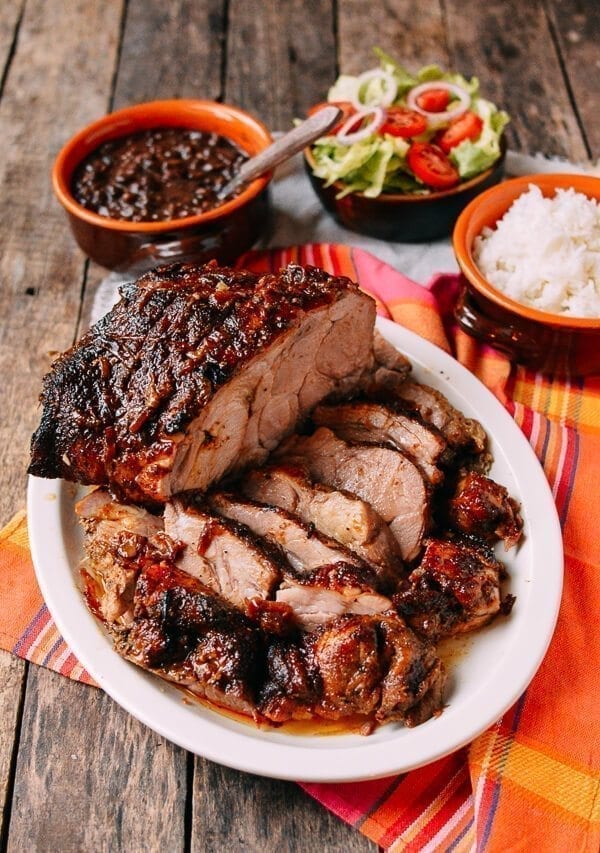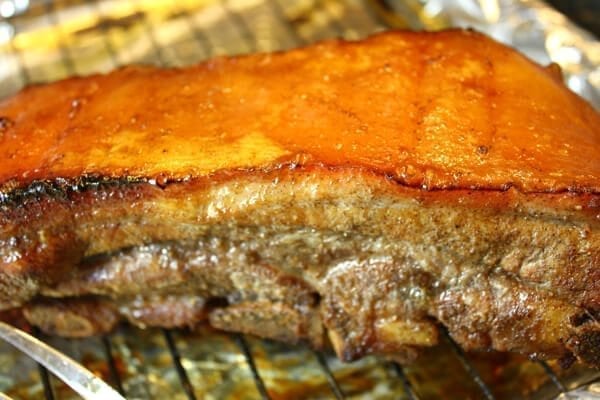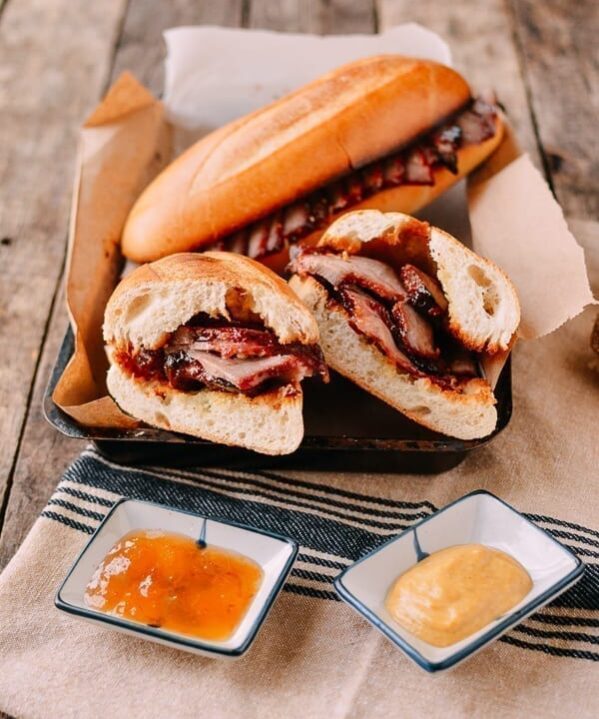Pernil is a Puerto Rican slow-roasted marinated pork shoulder, typically served around Christmastime. That said, this pernil recipe is so simple to make that you’ll want to enjoy this incredibly juicy and delicious pork roast all year round!
A Recipe from Kitchen Coworkers
This pernil-style roast pork recipe comes from my friends and fellow coworkers from when I was a teenager working in the Kitchen at the Liberty, NY Holiday Inn. Aside from my father and one part-time Chinese chef that the Holiday Inn restaurant hired for summer crowds, the rest of the kitchen staff were from Puerto Rico.
I was able to not only learn and practice a lot of my high school Spanish, I also managed to pick up some classic recipes and flavors. Over the years, both the Spanish and the love of all foods Caribbean and Latin American stuck, and I used some of my experience to create this pernil recipe.
Complete with beans, rice, and a simple salad on the side, this one of my favorite roast recipes, because it is juicy and just out-of-this-world tasty. It permeates the entire house with a beautiful porky, Latin food aroma that our whole family enjoys. Put the roast in the oven, and you’re on your way to a lazy food coma Sunday afternoon!
An easy pernil recipe
The key to a tasty roast pork is in the marinade and using a pork roast with just enough fat to give you a nice crispy crust out of the oven.
I won’t call this classic, traditional, or authentic, but I will say it’s a recipe I learned while working in a predominantly Puerto Rican-staffed kitchen during some of the most memorable summers of my life.
But I have modified it over the years, including using a boneless pork roast. Of course, this is in no way meant to downplay the benefits of a bone-in, skin-on pork shoulder or fresh ham. I’ve had many a tasty pernil with crackling skin. But it does make prep and cooking easier!
For the marinade, key ingredients include: garlic, an acid like vinegar and/or citrus juice, and oregano. Do not skip the overnight marinade, which is key to ensuring that the flavor penetrates the pork!
A bed of onions forms the “rack” that the pork roasts on in the pan—no special equipment needed. Those onions are incredibly delicious. I wouldn’t blame you for wanting to add extra to the pan!
Another key here is adding water to the roasting pan. This prevents burning and crusting at the bottom of the pan. Instead, it creates a pool of beautiful pork juices, perfect for soaking into your rice and beans. (Traditional arroz con gandules, or rice with pigeon peas, is also a delicious accompaniment!)
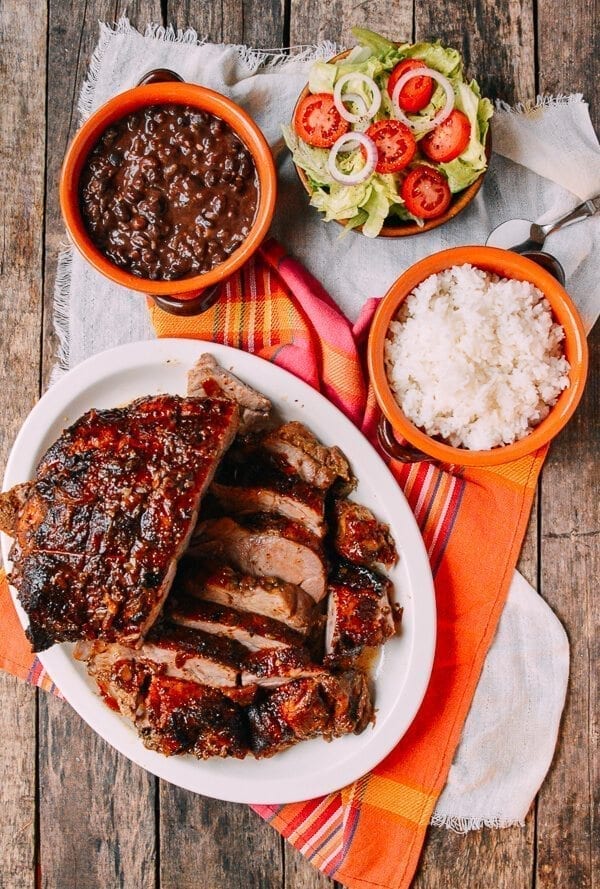
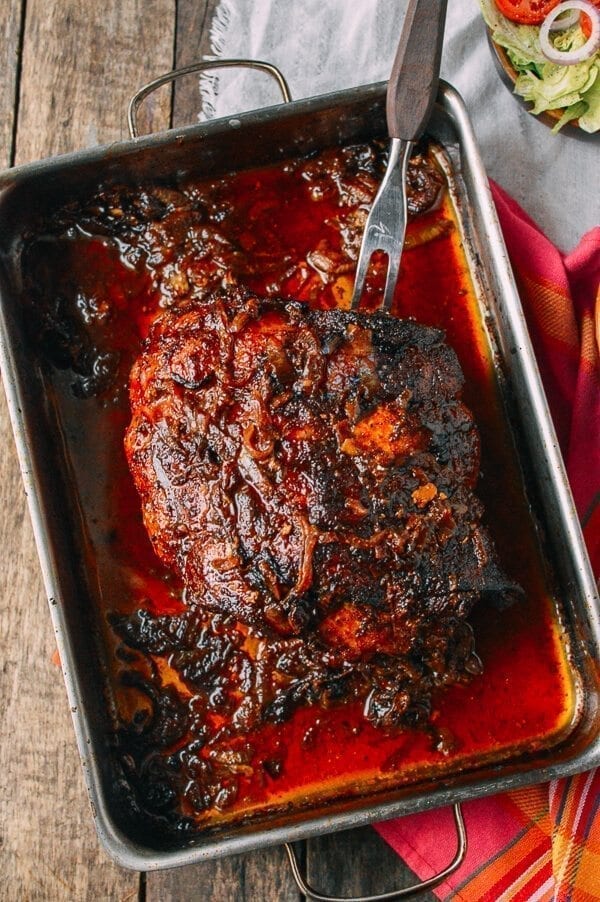
Note!
Following the main recipe, I’ve also included the recipes for preparing the rice, beans, and salad you see in the photos!
Buying Pork for Pernil
The traditional cut for pernil is a pork leg or shoulder. The easiest cut to find in grocery stores these days is the pork “picnic shoulder,” which is the lower part of the shoulder. It is one of the few pork cuts in grocery stores today that still comes with the skin on.
Many say that the crackling skin is a key component of pernil, and I won’t argue with that! That said, an even easier cut to get access to—and cook—is the upper part of the pork shoulder, also known as a pork butt or Boston butt. Both the picnic shoulder and pork butt have ample fat, making them ideal for slow roasting.
In this recipe, I used pork butt. You can find it bone-in or boneless. The shape of the piece of pork is more even in thickness, making it easy to cook. A boneless roast is a snap to slice or pull apart, and even a bone-in pork butt only has a small bone in the middle—the shoulder blade—that is easy to slice around.
How to Make Pernil
This is one of those recipes that looks incredibly impressive, but is very simple to make. The marinade only takes a few minutes to put together. Here is an outline of the recipe steps:
- Make the marinade (you likely have all of the ingredients on hand!), and rub it all over the pork. Marinate overnight.
- The next day, take the pork out of the refrigerator for 2 hours.
- Roast at high temp (425°F/220°C) for 1 hour.
- Finish roasting at lower temperature (350°F/170°C) for 2-3 hours
Can i make this with a smaller/bigger Pork roast?
Yes, just scale the marinade quantities up or down accordingly according to the weight of your roast. Tap/Click on the number of servings in our recipe card, and use the slider to scale the recipe.
This recipe is so easy to make that I found out Sarah has been making it on weeknights for herself and Justin using a smaller roast! (**Sarah here, interrupting my dad’s post. I serve it with the green sauce from our Peruvian Roast Chicken recipe, and it’s in my top 10 favorite meals ever.**)
Now let’s talk cooking time adjustments.
30-40 minutes per pound is a good rule of thumb. Total roasting time is divided between a short high heat cook and longer roasting at a lower temperature.
For a smaller roast: It depends on the size/shape of your roast. A 5 pound roast will stay closer to the to the original prescribed cooking time, and probably doesn’t need much modification—still roast at 425°F/220°C for 1 hour, and then roast for 2 hours. For a very small 3 pound piece of pork butt, reduce the initial cooking time at 425°F/220°C to 40 minutes total (don’t forget to turn the pan 180° halfway through). Then cook the roast at 350°F/170°C for 1 hour and 20 minutes. All that said, you will get best (juiciest) results with a larger roast, which will have more fat and juices!
For a larger roast: You can still do the initial high heat roast (at 425°F/220°C) for 1 hour. Then cook for the longer end of the range—3-3.5 hours. You won’t have to go much longer than that, because the pork roast can only be so thick!
Here’s a guide to cooking times according to the weight of your roast*:
3 pounds: Roast at 425°F/120°C for 40 minutes, then at 350°F/170°C for 1 hour 20 minutes
4 pounds: Roast at 425°F/120°C for 50 minutes, then at 350°F/170°C for 1 hour 30 minutes
5 pounds: Roast at 425°F/120°C for 1 hour, then at 350°F/170°C for 2 hours
6-7 pounds: Roast at 425°F/120°C for 1 hour, then at 350°F/170°C for 2-3 hours
8-10 pounds: Roast at 425°F/120°C for 1 hour, then at 350°F/170°C for 3-3.5 hours
*Temps and times are for a conventional oven, not a fan-assisted/convection oven.
Okay, let’s get to the recipe and photos! We have lots of tips and answers to FAQs in the step-by-step below, but if you want to get to the condensed version of the recipe, see the recipe card.
Try to refrain from drooling on your phones and keyboards, and enjoy. Here’s to sharing favorite foods, because this is one of mine.
Pernil Roast Pork Recipe Instructions
Prepare a large roasting pan by spreading the sliced onions in the bottom.
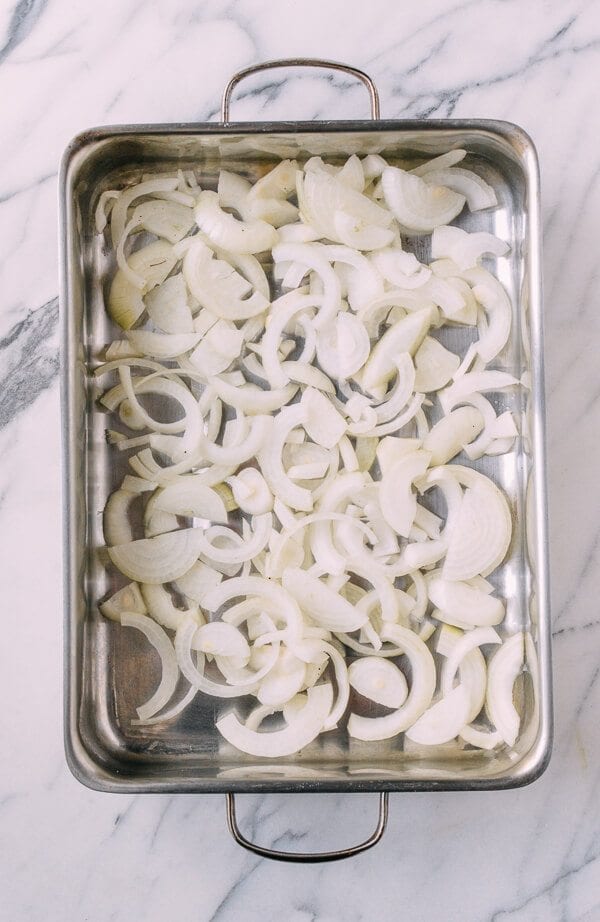
Rinse your pork roast, and pat dry with a paper towel. Place in the roasting pan.
Make the marinade by mixing together the minced garlic, olive oil, vinegar, lime juice, and all of the dry herbs and spices in a bowl.
You could also make the marinade in a mortar and pestle to really pulverize the garlic and make a nice smooth paste. If you don’t have a mortar and pestle, doing it in the food processor or simply mixing it in a bowl with minced garlic works fine as well.


Rub the entire roast with the marinade, ensuring that all areas of the roast are completely covered. If you’re using a boneless roast, already tied by the butcher, try to work some of the marinade into the empty cavity where the bone used to be.
If you know how to tie your own roast, marinating the meat before tying the roast will ensure the best results. Marinating is the most important step!
Using a skin-on pork shoulder?
If you’re using a roast with skin, score the skin with a sharp knife to form a cross-hatch pattern. Again, take your time to thoroughly rub the marinade all over the roast.
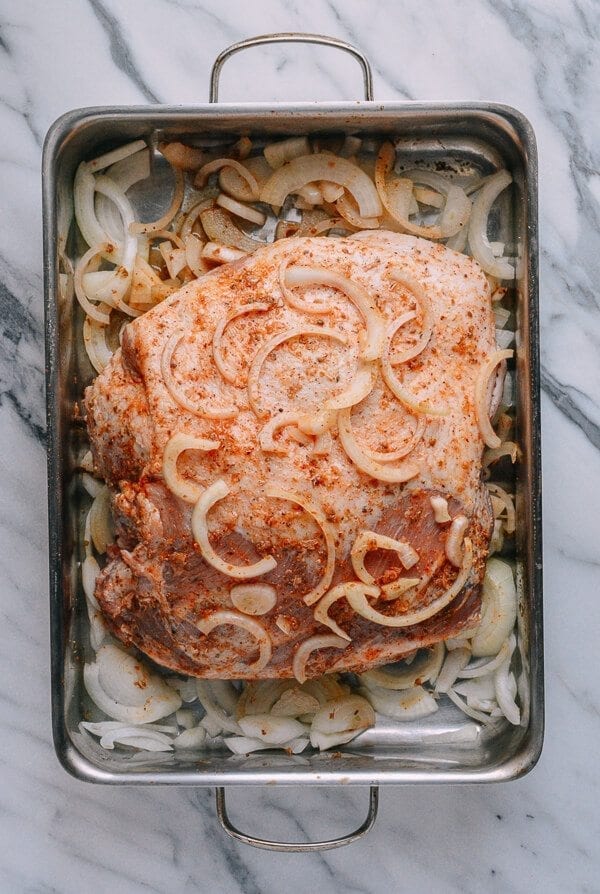
Next, cover the roast with plastic wrap and let it marinate overnight for at least 18 hours for the best results.
Covering with plastic wrap vs. foil
We rarely use plastic wrap in our house (we try to reduce plastic use generally), but this is one occasion where it is going to be a better option than foil. The salt and acidic ingredients in the marinade will eat through the aluminum, putting holes into the foil.
If this happens, the food underneath is still safe to eat, so no worries if you did cover the roast with foil. Likewise, it is safe to cook this roast in an aluminum/foil roasting pan, though a stainless steel pan will serve you even better!
Take the roast out of the refrigerator. Let it come up to room temperature, about 2 hours.
Preheat the oven to 425°F/220°C. Add 1 cup of water to the roasting pan.
Cook the roast at 425°F/220°C for 30 minutes. Then turn the roasting pan 180 degrees, and roast for another 30 minutes.
Reduce the heat to 350°F/170°C, and continue cooking for 2-3 hours, adding about ½ a cup of water every half hour, or as needed. You don’t want to let the bottom of the pan dry out and burn.
Once the roast is browned to your liking, tent with aluminum foil. (Place a sheet of aluminum foil on top of the roast with the sides exposed.)
Should Pernil Be Cooked Covered or Uncovered
Generally, you will want to cook the roast uncovered. That said, if you’re getting dark crusty spots on top of the roast, it’s a good idea to tent it with aluminum foil! You don’t have to seal the foil around the roasting pan—it can just lay over the top.

Let the meat rest for 15 minutes before serving. Slice or cut the roast into large chunks for a more rustic taste and feel.
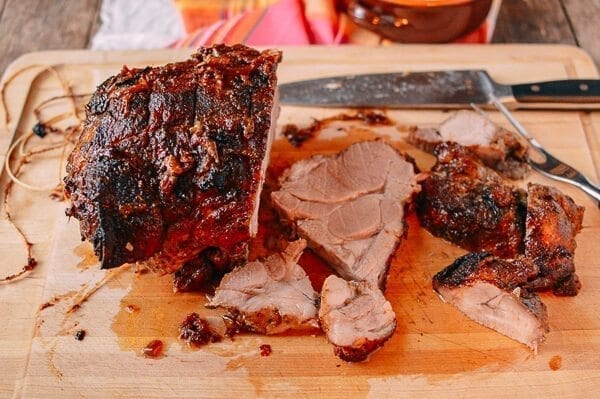
Pour the onions and juice from the pan over the meat to serve, alongside rice, salad and beans! If you’re up to it, splurge and make a few tostones (fried plantains)!
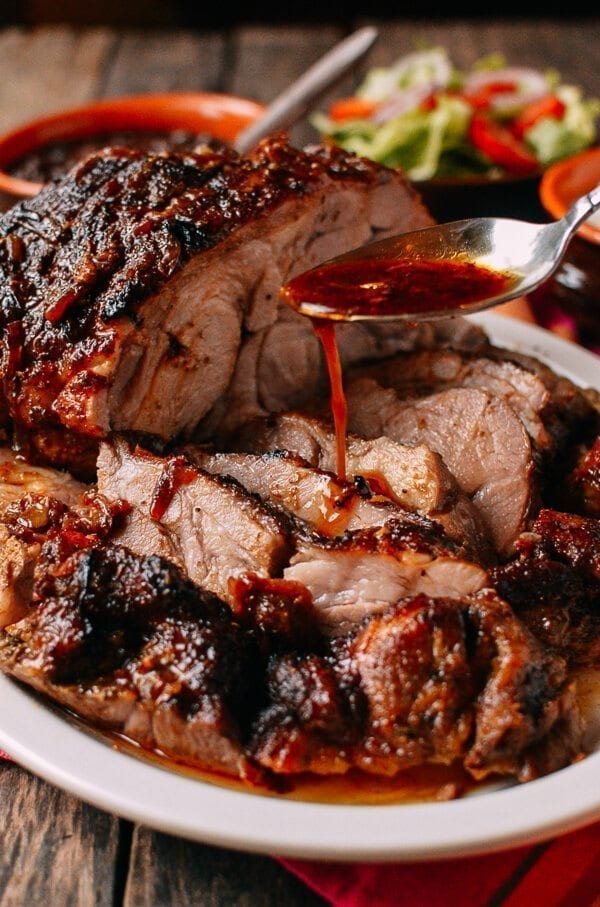
Can i make this with a smaller/bigger Pork roast?
Yes, just scale the marinade quantities up or down accordingly according to the weight of your roast. Tap/Click on the number of servings in our recipe card, and use the slider to scale the recipe.
Smaller roast: This recipe is so easy to make, that I found out recently Sarah has been making it on weeknights for herself and Justin using a smaller roast! 30-40 minutes per pound is a good rule of thumb. It depends on the size/shape of your roast. A 5 pound roast will stay closer to the to the original prescribed cooking time, and probably doesn’t need much modification—still roast at 425°F/220°C for 1 hour, and then roast for 2 hours. For a very small 3 pound roast, reduce the initial cooking time at 425°F/220°C to 40 minutes total (don’t forget to turn the pan 180° halfway through). Then cook the roast at 350°F/170°C for 1 hour and 20 minutes.
Larger roast: You can still do the initial high heat roast (at 425°F/220°C) for 1 hour. Then cook for the longer end of the range—3-3.5 hours. You won’t have to go much longer than that, because the pork roast can only be so thick!
Preparing Side Dishes
If you’re interested to know how I prepared these side dishes, read on! You can prepare all these side dishes in the last hour or so of cooking the roast.
For the Beans:
- 1½ tablespoons olive oil
- 1 medium onion, diced
- 2 cloves garlic, minced
- ½ teaspoon paprika
- 1 small tomato, chopped
- 2 cans of beans–black, pink, or kidney, rinsed and drained
- ½ teaspoon salt
- 1 cup chicken stock
Head a pot over medium heat. Add the olive oil, and cook the onion and garlic, stirring occasionally, until translucent. Add the paprika and the chopped fresh tomato, and continue cooking on medium to low heat until the tomato begins to break up, taking care not to burn the mixture, about 2 minutes.
Stir in the beans, salt, and chicken stock, and bring to a simmer. Cover and simmer for 45 minutes, stirring occasionally until thickened. If there’s too much liquid in the beans, continue cooking uncovered to reduce. Set aside until ready to serve.
Tips:
Sarah here again, elbowing my way into my dad’s post. I make these beans almost exactly as my dad described above, but I often leave out the fresh tomato. After the roast is done cooking, stir a few spoonfuls of the juices from the bottom of the roasting pan into the beans and it’ll be *chef’s kiss* extra delicious.
For the Rice:
- 3 cups medium or long-grain rice
- water
- 1/2 teaspoon salt
- Pinch of fresh ground pepper
- 1 tablespoon olive oil
If you’re not using a rice cooker, soak the rice with about 1 inch of water on top for 20 minutes. Drain, and add to a medium pot, along with 3 cups of water. Add the salt, pepper, and olive oil, and cover the pot. Bring the rice to a boil over medium heat, and then reduce the heat to the lowest setting. Cover, and cook for another 20 minutes. Turn off the heat, and let sit on the stove, covered, until you’re ready to eat.
If using a rice cooker, add 4 rice cooker cups (which is equivalent to 3 US cups—standard rice cooker cups are US 3/4 cup) of rice to the cooker and fill with water to the #4 line. Stir in the salt, pepper, and olive oil. Cover, and press Start.
For the simple salad:
- 2 ripe plum tomatoes, sliced
- 1 small red onion, thinly sliced and rinsed in very cold water (for extra crunch)
- Iceberg or Romaine lettuce, torn into bite-sized pieces
- Equal parts olive oil and red wine vinegar
- Salt and pepper to taste
Place the plum tomatoes and red onions on a bed of your lettuce of choice. Stir the oil, vinegar, salt and pepper together, and pour over the salad when ready to serve.
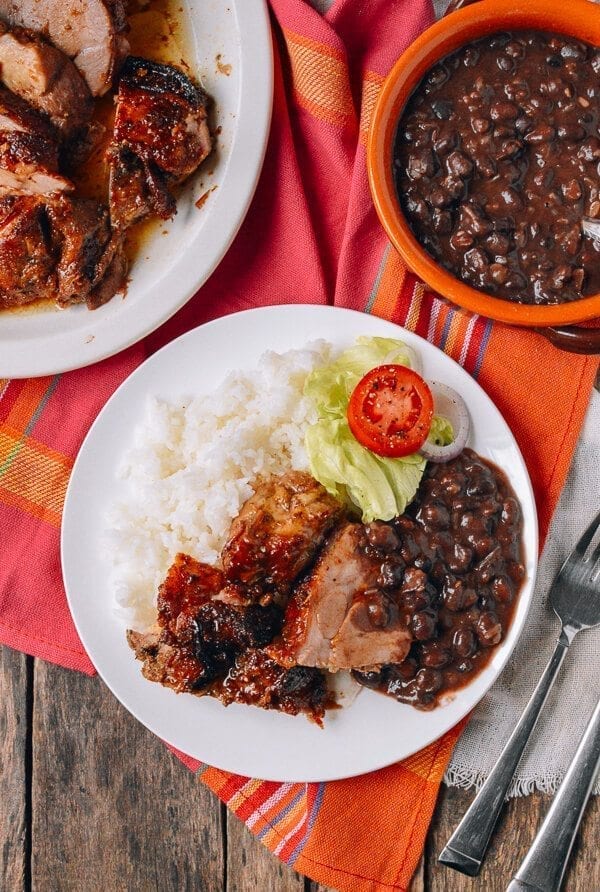
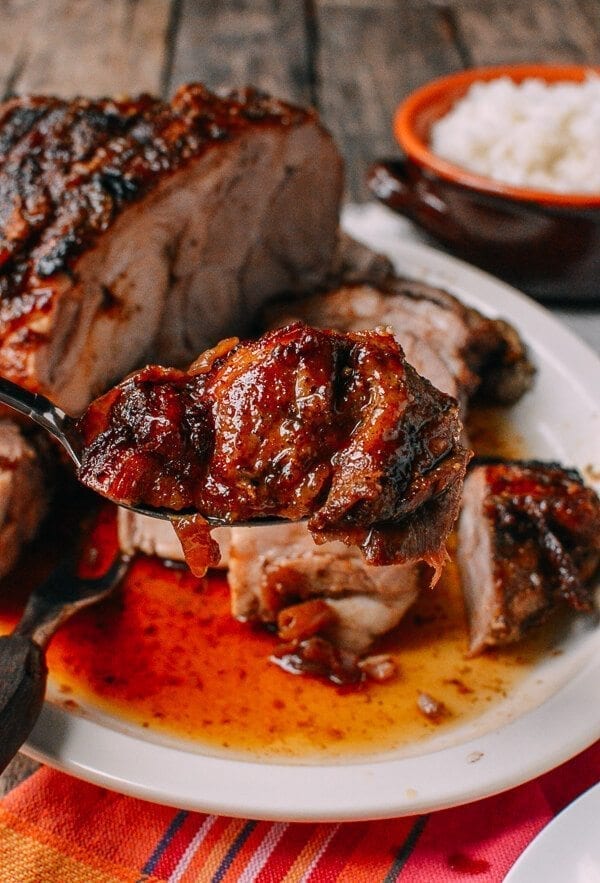

Pernil-Style Roast Pork
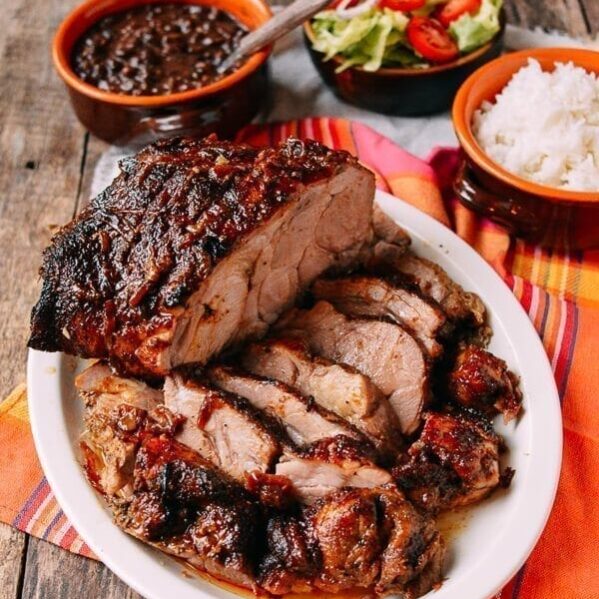
Ingredients
- 2 large onions (sliced)
- 6 pound boneless pork shoulder or pork butt (skin-on, optional)
- 5 cloves garlic (minced, about 2 tablespoons)
- 2 tablespoons olive oil
- 1½ tablespoons apple cider vinegar
- 1 tablespoon fresh lime juice
- 1½ tablespoons dried oregano
- 1 teaspoon onion powder
- ½ teaspoon ground cumin
- 1 teaspoon chili powder
- 1½ teaspoons sugar
- 1½ tablespoons salt
- 1 teaspoon freshly ground black pepper
- Water
Instructions
- Spread the sliced onions in the bottom of a large roasting pan. Rinse your roast and pat dry with a paper towel. Place in the pan on top of the onions.
- Make the marinade by combining the minced garlic, olive oil, apple cider vinegar, lime juice, oregano, onion powder, cumin, chili powder, sugar, salt, and pepper. You can also do this in a mortar and pestle.
- Rub the entire roast with the marinade, ensuring it is completely covered. If you’re using a boneless roast, already tied by the butcher, try to work some of the marinade in the empty cavity where the bone used to be. If using a skin-on roast, score the skin with a sharp knife to form a cross-hatch pattern before marinating.
- Cover the roast with plastic wrap, and marinate overnight.
- About 5-6 hours before you'd like to eat, take the roast out of the refrigerator, and let it sit on the counter for about 2 hours.
- Place a rack in the center of the oven, and preheat to 425°F/220°C. Add 1 cup of water to the roasting pan, and cook the roast for 30 minutes. Then rotate the pan 180°, and cook for another 30 minutes.
- Reduce the heat to 350°F/170°C, and continue cooking for 2-3 hours, adding about ½ a cup of water every half hour or as needed (don't let the bottom of the pan dry out and burn). Once the roast is browned to your liking, tent it with aluminum foil.
- Let the meat rest for 15 minutes before serving.
